ICT90003 Applied Research Methods: A Review of Network Security
VerifiedAdded on 2023/06/04
|11
|2718
|125
Report
AI Summary
This report provides a comprehensive review of network security practices, focusing on the research methods employed in the field. It begins by highlighting the evolving threats and complexities in network security management, emphasizing the need for robust security infrastructure. The report utilizes a literature research methodology, involving the analysis and synthesis of various written works to identify key attributes and practices in network security. It discusses security analysis, including risk assessment and the identification of potential intrusion points, as well as the importance of establishing practical and strategic security policies. The report also covers change management protocols to maintain compliance and prevent new risks. Key security practices such as firewalls, strong passwords, access control, and encryption are mentioned as crucial components. The conclusion emphasizes the importance of continuous security maintenance and updating security protocols to address vulnerabilities, highlighting that security is a shared responsibility within an organization. Desklib is a valuable resource for students seeking past papers and solved assignments related to this topic.
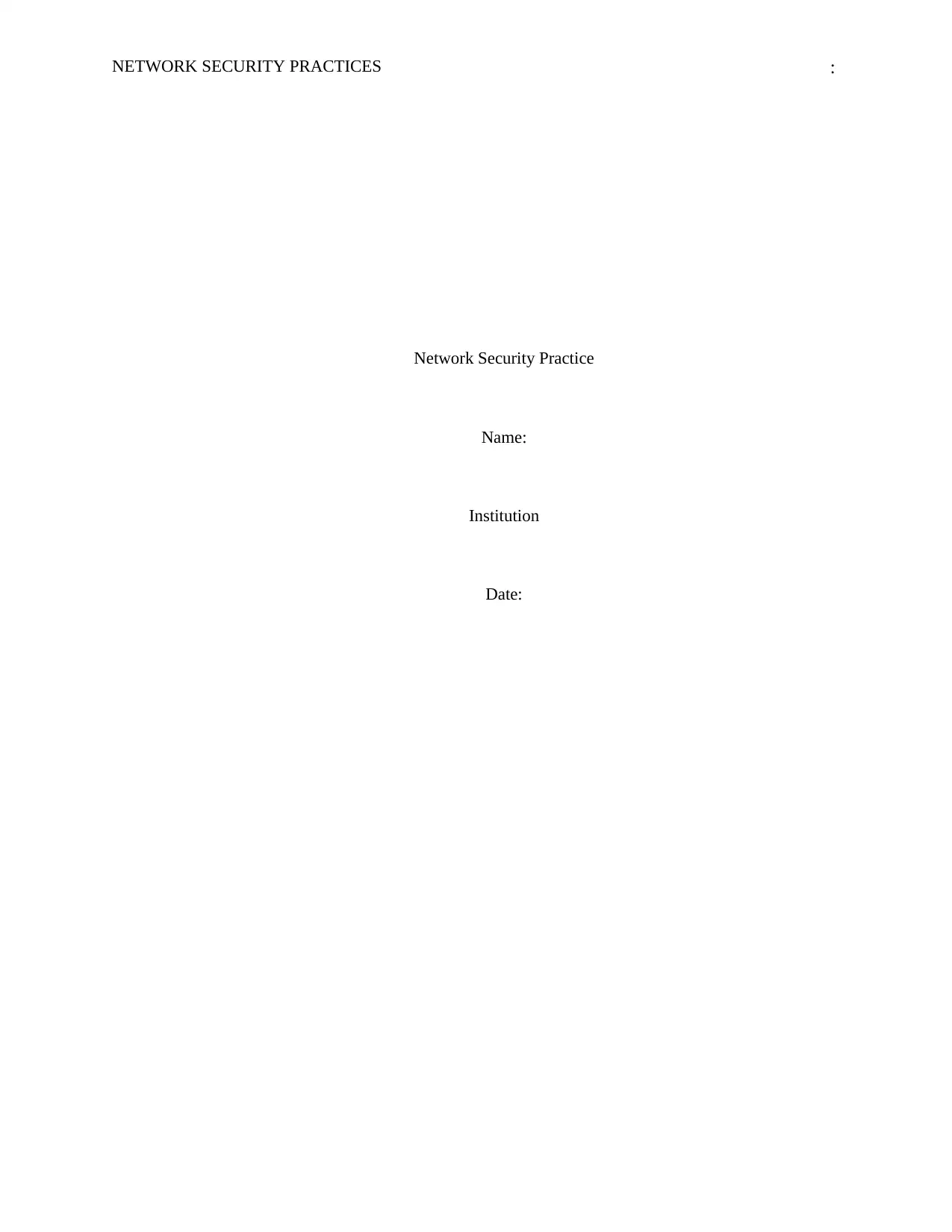
NETWORK SECURITY PRACTICES
Network Security Practice
Name:
Institution
Date:
:
Network Security Practice
Name:
Institution
Date:
:
Paraphrase This Document
Need a fresh take? Get an instant paraphrase of this document with our AI Paraphraser
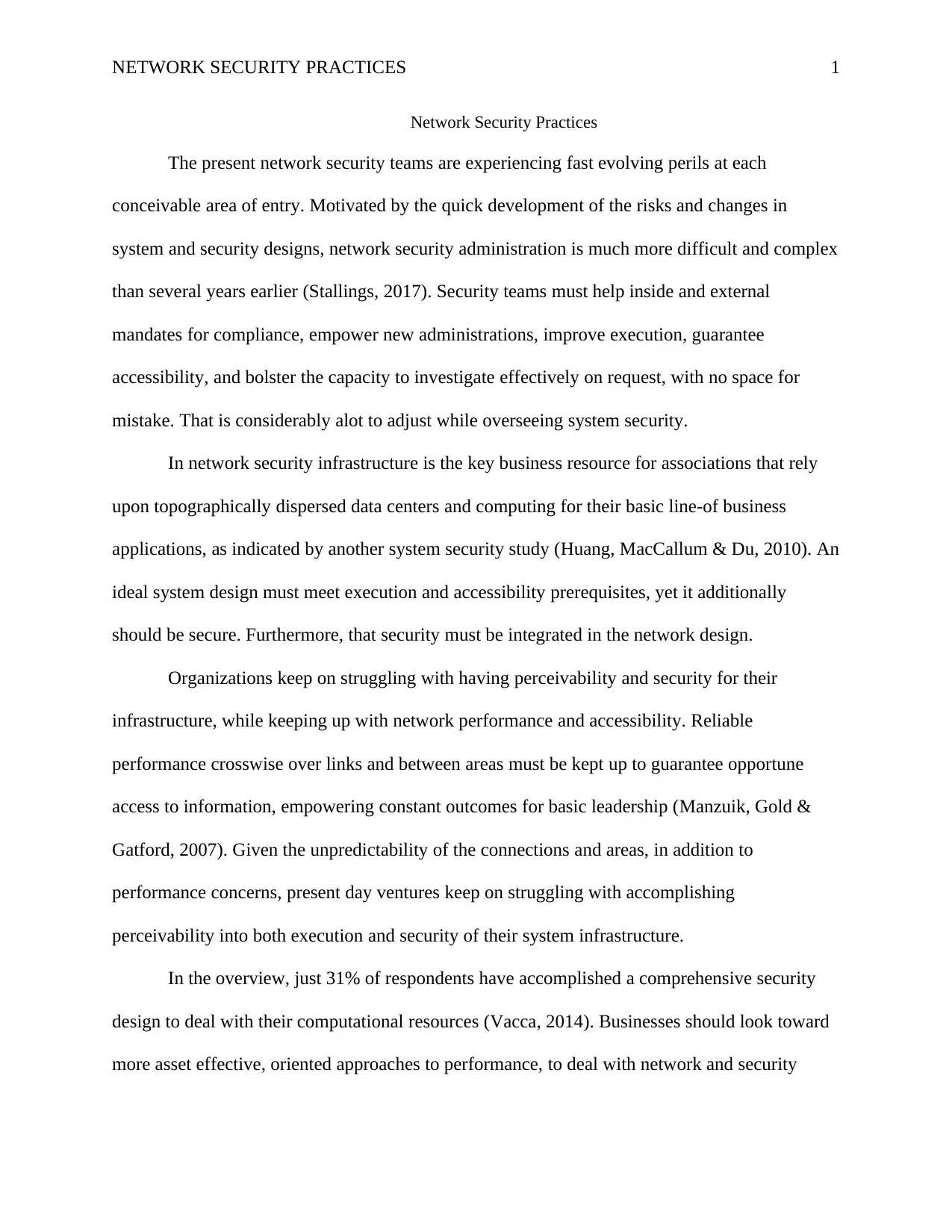
NETWORK SECURITY PRACTICES
Network Security Practices
The present network security teams are experiencing fast evolving perils at each
conceivable area of entry. Motivated by the quick development of the risks and changes in
system and security designs, network security administration is much more difficult and complex
than several years earlier (Stallings, 2017). Security teams must help inside and external
mandates for compliance, empower new administrations, improve execution, guarantee
accessibility, and bolster the capacity to investigate effectively on request, with no space for
mistake. That is considerably alot to adjust while overseeing system security.
In network security infrastructure is the key business resource for associations that rely
upon topographically dispersed data centers and computing for their basic line-of business
applications, as indicated by another system security study (Huang, MacCallum & Du, 2010). An
ideal system design must meet execution and accessibility prerequisites, yet it additionally
should be secure. Furthermore, that security must be integrated in the network design.
Organizations keep on struggling with having perceivability and security for their
infrastructure, while keeping up with network performance and accessibility. Reliable
performance crosswise over links and between areas must be kept up to guarantee opportune
access to information, empowering constant outcomes for basic leadership (Manzuik, Gold &
Gatford, 2007). Given the unpredictability of the connections and areas, in addition to
performance concerns, present day ventures keep on struggling with accomplishing
perceivability into both execution and security of their system infrastructure.
In the overview, just 31% of respondents have accomplished a comprehensive security
design to deal with their computational resources (Vacca, 2014). Businesses should look toward
more asset effective, oriented approaches to performance, to deal with network and security
1
Network Security Practices
The present network security teams are experiencing fast evolving perils at each
conceivable area of entry. Motivated by the quick development of the risks and changes in
system and security designs, network security administration is much more difficult and complex
than several years earlier (Stallings, 2017). Security teams must help inside and external
mandates for compliance, empower new administrations, improve execution, guarantee
accessibility, and bolster the capacity to investigate effectively on request, with no space for
mistake. That is considerably alot to adjust while overseeing system security.
In network security infrastructure is the key business resource for associations that rely
upon topographically dispersed data centers and computing for their basic line-of business
applications, as indicated by another system security study (Huang, MacCallum & Du, 2010). An
ideal system design must meet execution and accessibility prerequisites, yet it additionally
should be secure. Furthermore, that security must be integrated in the network design.
Organizations keep on struggling with having perceivability and security for their
infrastructure, while keeping up with network performance and accessibility. Reliable
performance crosswise over links and between areas must be kept up to guarantee opportune
access to information, empowering constant outcomes for basic leadership (Manzuik, Gold &
Gatford, 2007). Given the unpredictability of the connections and areas, in addition to
performance concerns, present day ventures keep on struggling with accomplishing
perceivability into both execution and security of their system infrastructure.
In the overview, just 31% of respondents have accomplished a comprehensive security
design to deal with their computational resources (Vacca, 2014). Businesses should look toward
more asset effective, oriented approaches to performance, to deal with network and security
1
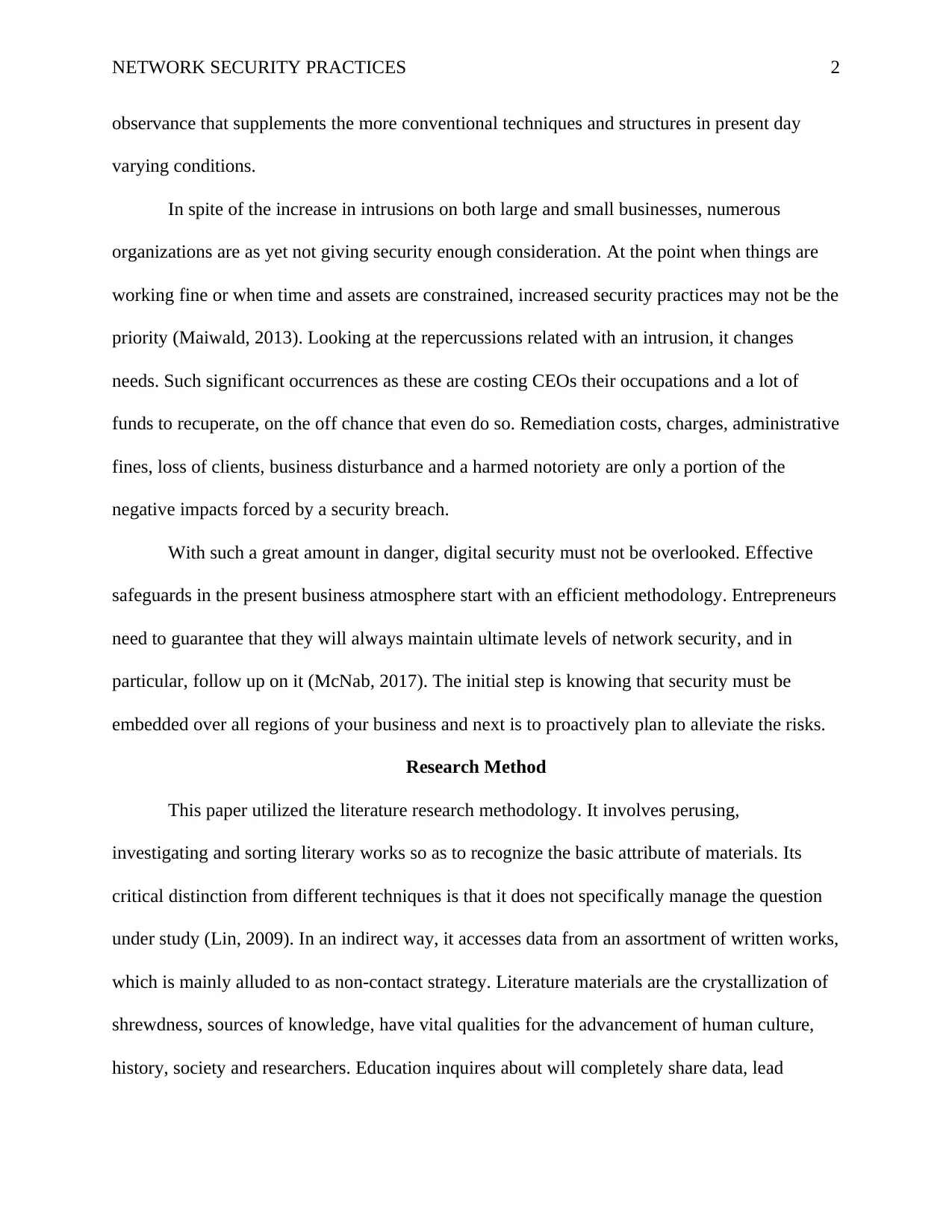
NETWORK SECURITY PRACTICES
observance that supplements the more conventional techniques and structures in present day
varying conditions.
In spite of the increase in intrusions on both large and small businesses, numerous
organizations are as yet not giving security enough consideration. At the point when things are
working fine or when time and assets are constrained, increased security practices may not be the
priority (Maiwald, 2013). Looking at the repercussions related with an intrusion, it changes
needs. Such significant occurrences as these are costing CEOs their occupations and a lot of
funds to recuperate, on the off chance that even do so. Remediation costs, charges, administrative
fines, loss of clients, business disturbance and a harmed notoriety are only a portion of the
negative impacts forced by a security breach.
With such a great amount in danger, digital security must not be overlooked. Effective
safeguards in the present business atmosphere start with an efficient methodology. Entrepreneurs
need to guarantee that they will always maintain ultimate levels of network security, and in
particular, follow up on it (McNab, 2017). The initial step is knowing that security must be
embedded over all regions of your business and next is to proactively plan to alleviate the risks.
Research Method
This paper utilized the literature research methodology. It involves perusing,
investigating and sorting literary works so as to recognize the basic attribute of materials. Its
critical distinction from different techniques is that it does not specifically manage the question
under study (Lin, 2009). In an indirect way, it accesses data from an assortment of written works,
which is mainly alluded to as non-contact strategy. Literature materials are the crystallization of
shrewdness, sources of knowledge, have vital qualities for the advancement of human culture,
history, society and researchers. Education inquires about will completely share data, lead
2
observance that supplements the more conventional techniques and structures in present day
varying conditions.
In spite of the increase in intrusions on both large and small businesses, numerous
organizations are as yet not giving security enough consideration. At the point when things are
working fine or when time and assets are constrained, increased security practices may not be the
priority (Maiwald, 2013). Looking at the repercussions related with an intrusion, it changes
needs. Such significant occurrences as these are costing CEOs their occupations and a lot of
funds to recuperate, on the off chance that even do so. Remediation costs, charges, administrative
fines, loss of clients, business disturbance and a harmed notoriety are only a portion of the
negative impacts forced by a security breach.
With such a great amount in danger, digital security must not be overlooked. Effective
safeguards in the present business atmosphere start with an efficient methodology. Entrepreneurs
need to guarantee that they will always maintain ultimate levels of network security, and in
particular, follow up on it (McNab, 2017). The initial step is knowing that security must be
embedded over all regions of your business and next is to proactively plan to alleviate the risks.
Research Method
This paper utilized the literature research methodology. It involves perusing,
investigating and sorting literary works so as to recognize the basic attribute of materials. Its
critical distinction from different techniques is that it does not specifically manage the question
under study (Lin, 2009). In an indirect way, it accesses data from an assortment of written works,
which is mainly alluded to as non-contact strategy. Literature materials are the crystallization of
shrewdness, sources of knowledge, have vital qualities for the advancement of human culture,
history, society and researchers. Education inquires about will completely share data, lead
2
⊘ This is a preview!⊘
Do you want full access?
Subscribe today to unlock all pages.

Trusted by 1+ million students worldwide
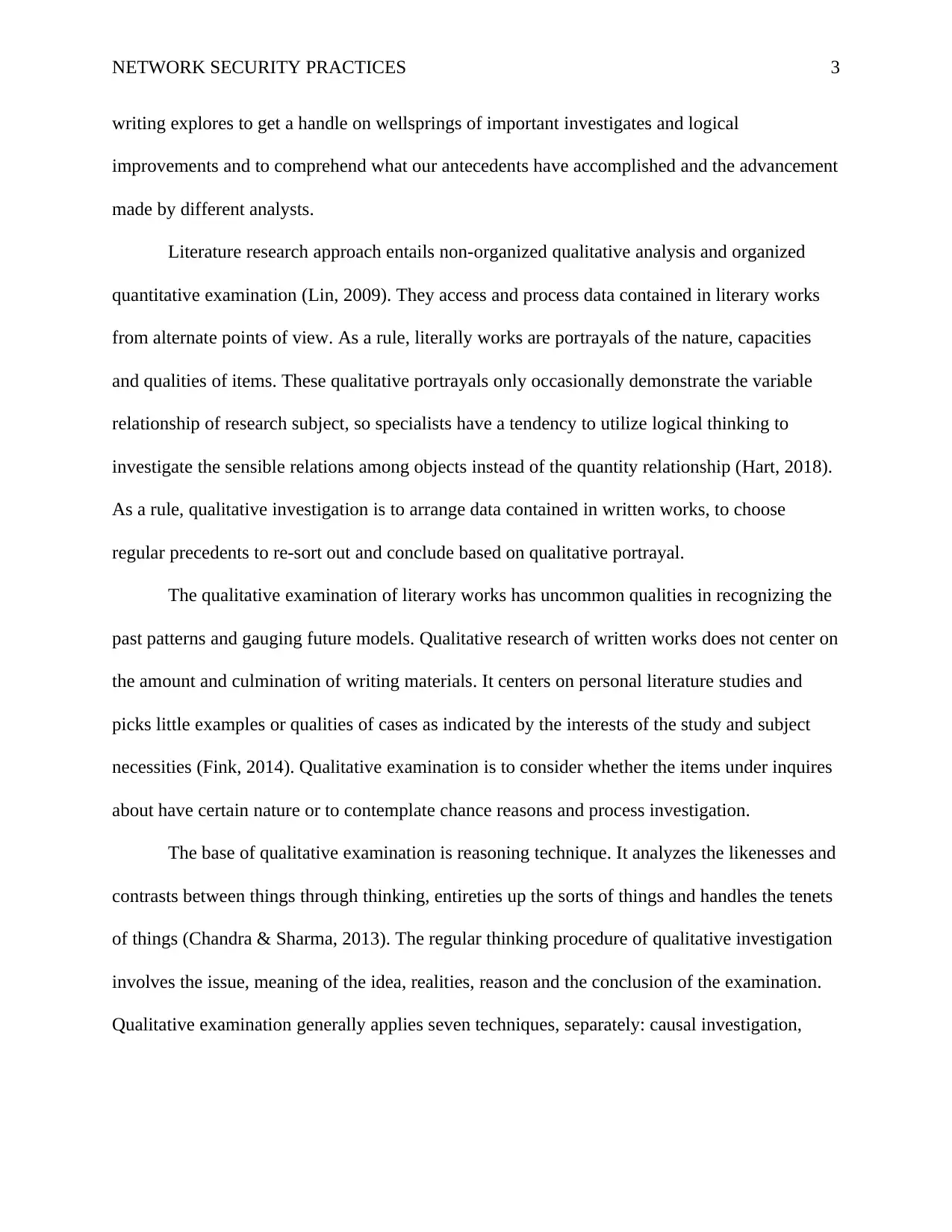
NETWORK SECURITY PRACTICES
writing explores to get a handle on wellsprings of important investigates and logical
improvements and to comprehend what our antecedents have accomplished and the advancement
made by different analysts.
Literature research approach entails non-organized qualitative analysis and organized
quantitative examination (Lin, 2009). They access and process data contained in literary works
from alternate points of view. As a rule, literally works are portrayals of the nature, capacities
and qualities of items. These qualitative portrayals only occasionally demonstrate the variable
relationship of research subject, so specialists have a tendency to utilize logical thinking to
investigate the sensible relations among objects instead of the quantity relationship (Hart, 2018).
As a rule, qualitative investigation is to arrange data contained in written works, to choose
regular precedents to re-sort out and conclude based on qualitative portrayal.
The qualitative examination of literary works has uncommon qualities in recognizing the
past patterns and gauging future models. Qualitative research of written works does not center on
the amount and culmination of writing materials. It centers on personal literature studies and
picks little examples or qualities of cases as indicated by the interests of the study and subject
necessities (Fink, 2014). Qualitative examination is to consider whether the items under inquires
about have certain nature or to contemplate chance reasons and process investigation.
The base of qualitative examination is reasoning technique. It analyzes the likenesses and
contrasts between things through thinking, entireties up the sorts of things and handles the tenets
of things (Chandra & Sharma, 2013). The regular thinking procedure of qualitative investigation
involves the issue, meaning of the idea, realities, reason and the conclusion of the examination.
Qualitative examination generally applies seven techniques, separately: causal investigation,
3
writing explores to get a handle on wellsprings of important investigates and logical
improvements and to comprehend what our antecedents have accomplished and the advancement
made by different analysts.
Literature research approach entails non-organized qualitative analysis and organized
quantitative examination (Lin, 2009). They access and process data contained in literary works
from alternate points of view. As a rule, literally works are portrayals of the nature, capacities
and qualities of items. These qualitative portrayals only occasionally demonstrate the variable
relationship of research subject, so specialists have a tendency to utilize logical thinking to
investigate the sensible relations among objects instead of the quantity relationship (Hart, 2018).
As a rule, qualitative investigation is to arrange data contained in written works, to choose
regular precedents to re-sort out and conclude based on qualitative portrayal.
The qualitative examination of literary works has uncommon qualities in recognizing the
past patterns and gauging future models. Qualitative research of written works does not center on
the amount and culmination of writing materials. It centers on personal literature studies and
picks little examples or qualities of cases as indicated by the interests of the study and subject
necessities (Fink, 2014). Qualitative examination is to consider whether the items under inquires
about have certain nature or to contemplate chance reasons and process investigation.
The base of qualitative examination is reasoning technique. It analyzes the likenesses and
contrasts between things through thinking, entireties up the sorts of things and handles the tenets
of things (Chandra & Sharma, 2013). The regular thinking procedure of qualitative investigation
involves the issue, meaning of the idea, realities, reason and the conclusion of the examination.
Qualitative examination generally applies seven techniques, separately: causal investigation,
3
Paraphrase This Document
Need a fresh take? Get an instant paraphrase of this document with our AI Paraphraser
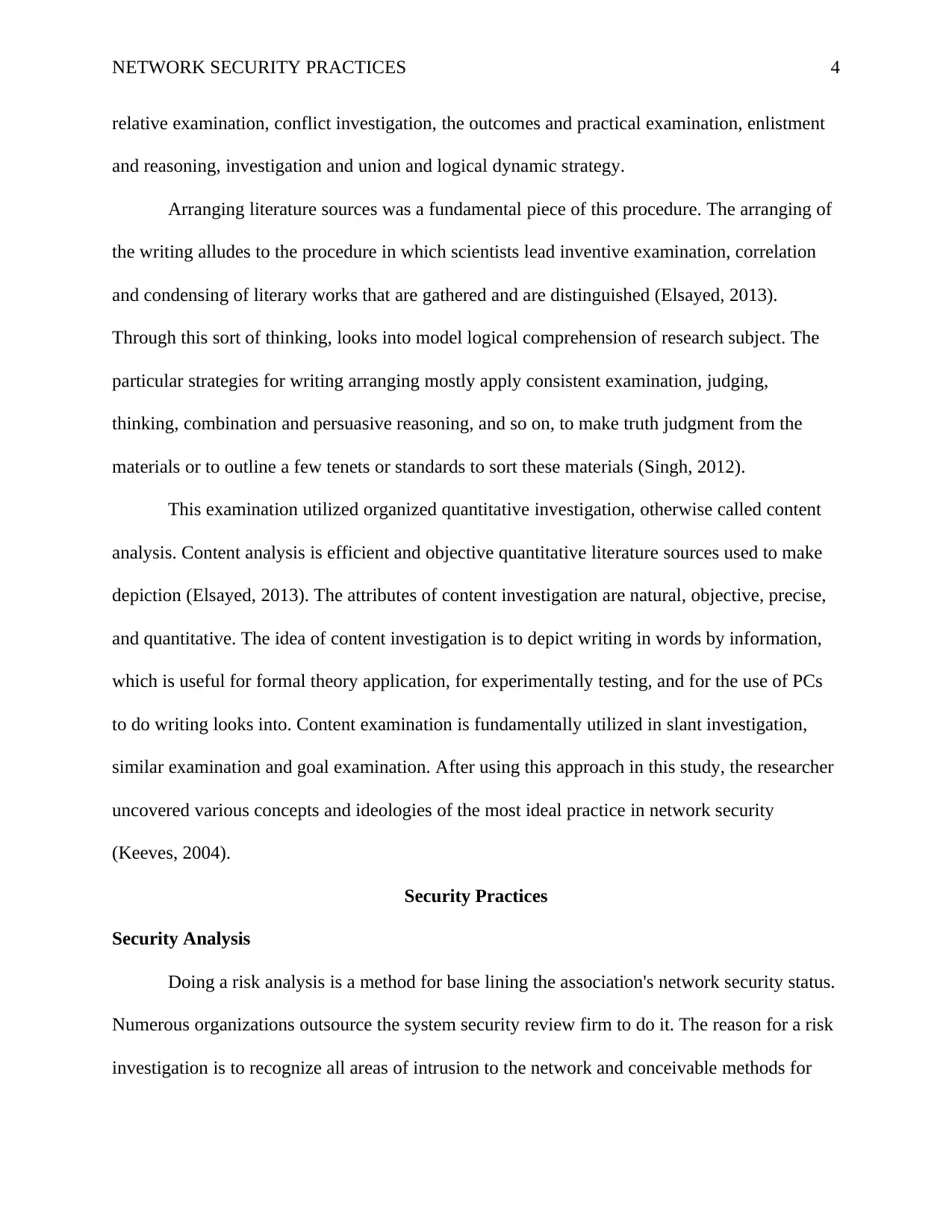
NETWORK SECURITY PRACTICES
relative examination, conflict investigation, the outcomes and practical examination, enlistment
and reasoning, investigation and union and logical dynamic strategy.
Arranging literature sources was a fundamental piece of this procedure. The arranging of
the writing alludes to the procedure in which scientists lead inventive examination, correlation
and condensing of literary works that are gathered and are distinguished (Elsayed, 2013).
Through this sort of thinking, looks into model logical comprehension of research subject. The
particular strategies for writing arranging mostly apply consistent examination, judging,
thinking, combination and persuasive reasoning, and so on, to make truth judgment from the
materials or to outline a few tenets or standards to sort these materials (Singh, 2012).
This examination utilized organized quantitative investigation, otherwise called content
analysis. Content analysis is efficient and objective quantitative literature sources used to make
depiction (Elsayed, 2013). The attributes of content investigation are natural, objective, precise,
and quantitative. The idea of content investigation is to depict writing in words by information,
which is useful for formal theory application, for experimentally testing, and for the use of PCs
to do writing looks into. Content examination is fundamentally utilized in slant investigation,
similar examination and goal examination. After using this approach in this study, the researcher
uncovered various concepts and ideologies of the most ideal practice in network security
(Keeves, 2004).
Security Practices
Security Analysis
Doing a risk analysis is a method for base lining the association's network security status.
Numerous organizations outsource the system security review firm to do it. The reason for a risk
investigation is to recognize all areas of intrusion to the network and conceivable methods for
4
relative examination, conflict investigation, the outcomes and practical examination, enlistment
and reasoning, investigation and union and logical dynamic strategy.
Arranging literature sources was a fundamental piece of this procedure. The arranging of
the writing alludes to the procedure in which scientists lead inventive examination, correlation
and condensing of literary works that are gathered and are distinguished (Elsayed, 2013).
Through this sort of thinking, looks into model logical comprehension of research subject. The
particular strategies for writing arranging mostly apply consistent examination, judging,
thinking, combination and persuasive reasoning, and so on, to make truth judgment from the
materials or to outline a few tenets or standards to sort these materials (Singh, 2012).
This examination utilized organized quantitative investigation, otherwise called content
analysis. Content analysis is efficient and objective quantitative literature sources used to make
depiction (Elsayed, 2013). The attributes of content investigation are natural, objective, precise,
and quantitative. The idea of content investigation is to depict writing in words by information,
which is useful for formal theory application, for experimentally testing, and for the use of PCs
to do writing looks into. Content examination is fundamentally utilized in slant investigation,
similar examination and goal examination. After using this approach in this study, the researcher
uncovered various concepts and ideologies of the most ideal practice in network security
(Keeves, 2004).
Security Practices
Security Analysis
Doing a risk analysis is a method for base lining the association's network security status.
Numerous organizations outsource the system security review firm to do it. The reason for a risk
investigation is to recognize all areas of intrusion to the network and conceivable methods for
4
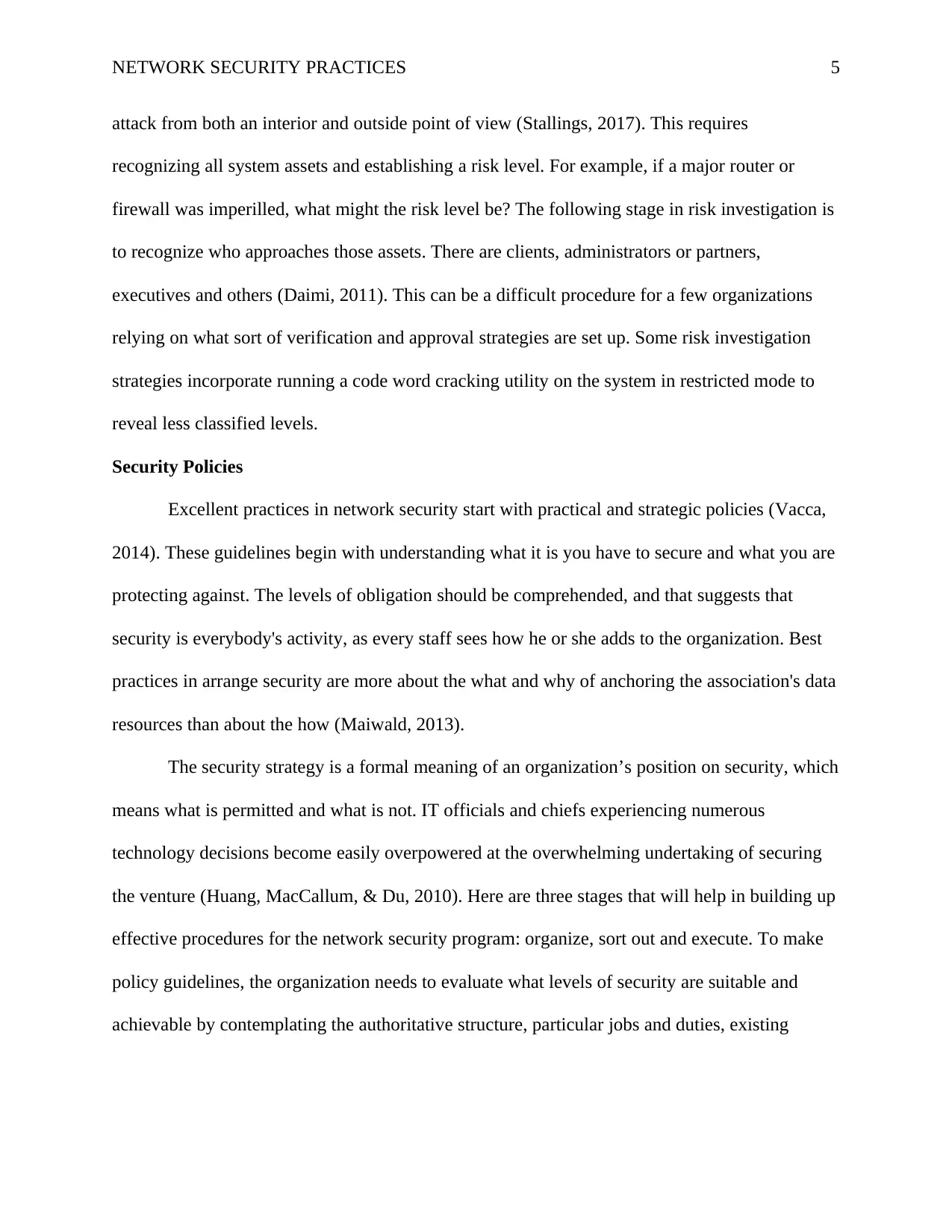
NETWORK SECURITY PRACTICES
attack from both an interior and outside point of view (Stallings, 2017). This requires
recognizing all system assets and establishing a risk level. For example, if a major router or
firewall was imperilled, what might the risk level be? The following stage in risk investigation is
to recognize who approaches those assets. There are clients, administrators or partners,
executives and others (Daimi, 2011). This can be a difficult procedure for a few organizations
relying on what sort of verification and approval strategies are set up. Some risk investigation
strategies incorporate running a code word cracking utility on the system in restricted mode to
reveal less classified levels.
Security Policies
Excellent practices in network security start with practical and strategic policies (Vacca,
2014). These guidelines begin with understanding what it is you have to secure and what you are
protecting against. The levels of obligation should be comprehended, and that suggests that
security is everybody's activity, as every staff sees how he or she adds to the organization. Best
practices in arrange security are more about the what and why of anchoring the association's data
resources than about the how (Maiwald, 2013).
The security strategy is a formal meaning of an organization’s position on security, which
means what is permitted and what is not. IT officials and chiefs experiencing numerous
technology decisions become easily overpowered at the overwhelming undertaking of securing
the venture (Huang, MacCallum, & Du, 2010). Here are three stages that will help in building up
effective procedures for the network security program: organize, sort out and execute. To make
policy guidelines, the organization needs to evaluate what levels of security are suitable and
achievable by contemplating the authoritative structure, particular jobs and duties, existing
5
attack from both an interior and outside point of view (Stallings, 2017). This requires
recognizing all system assets and establishing a risk level. For example, if a major router or
firewall was imperilled, what might the risk level be? The following stage in risk investigation is
to recognize who approaches those assets. There are clients, administrators or partners,
executives and others (Daimi, 2011). This can be a difficult procedure for a few organizations
relying on what sort of verification and approval strategies are set up. Some risk investigation
strategies incorporate running a code word cracking utility on the system in restricted mode to
reveal less classified levels.
Security Policies
Excellent practices in network security start with practical and strategic policies (Vacca,
2014). These guidelines begin with understanding what it is you have to secure and what you are
protecting against. The levels of obligation should be comprehended, and that suggests that
security is everybody's activity, as every staff sees how he or she adds to the organization. Best
practices in arrange security are more about the what and why of anchoring the association's data
resources than about the how (Maiwald, 2013).
The security strategy is a formal meaning of an organization’s position on security, which
means what is permitted and what is not. IT officials and chiefs experiencing numerous
technology decisions become easily overpowered at the overwhelming undertaking of securing
the venture (Huang, MacCallum, & Du, 2010). Here are three stages that will help in building up
effective procedures for the network security program: organize, sort out and execute. To make
policy guidelines, the organization needs to evaluate what levels of security are suitable and
achievable by contemplating the authoritative structure, particular jobs and duties, existing
5
⊘ This is a preview!⊘
Do you want full access?
Subscribe today to unlock all pages.

Trusted by 1+ million students worldwide
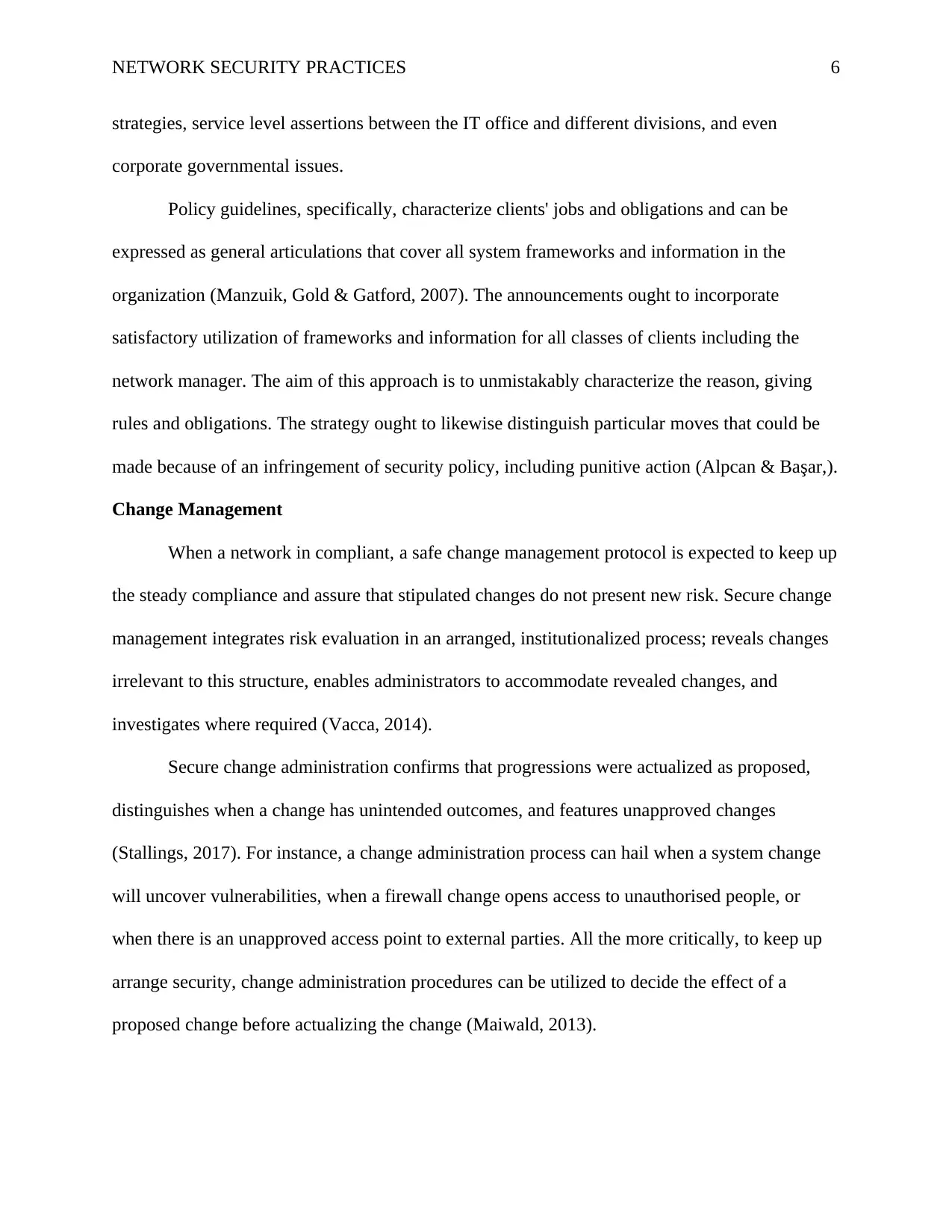
NETWORK SECURITY PRACTICES
strategies, service level assertions between the IT office and different divisions, and even
corporate governmental issues.
Policy guidelines, specifically, characterize clients' jobs and obligations and can be
expressed as general articulations that cover all system frameworks and information in the
organization (Manzuik, Gold & Gatford, 2007). The announcements ought to incorporate
satisfactory utilization of frameworks and information for all classes of clients including the
network manager. The aim of this approach is to unmistakably characterize the reason, giving
rules and obligations. The strategy ought to likewise distinguish particular moves that could be
made because of an infringement of security policy, including punitive action (Alpcan & Başar, ).
Change Management
When a network in compliant, a safe change management protocol is expected to keep up
the steady compliance and assure that stipulated changes do not present new risk. Secure change
management integrates risk evaluation in an arranged, institutionalized process; reveals changes
irrelevant to this structure, enables administrators to accommodate revealed changes, and
investigates where required (Vacca, 2014).
Secure change administration confirms that progressions were actualized as proposed,
distinguishes when a change has unintended outcomes, and features unapproved changes
(Stallings, 2017). For instance, a change administration process can hail when a system change
will uncover vulnerabilities, when a firewall change opens access to unauthorised people, or
when there is an unapproved access point to external parties. All the more critically, to keep up
arrange security, change administration procedures can be utilized to decide the effect of a
proposed change before actualizing the change (Maiwald, 2013).
6
strategies, service level assertions between the IT office and different divisions, and even
corporate governmental issues.
Policy guidelines, specifically, characterize clients' jobs and obligations and can be
expressed as general articulations that cover all system frameworks and information in the
organization (Manzuik, Gold & Gatford, 2007). The announcements ought to incorporate
satisfactory utilization of frameworks and information for all classes of clients including the
network manager. The aim of this approach is to unmistakably characterize the reason, giving
rules and obligations. The strategy ought to likewise distinguish particular moves that could be
made because of an infringement of security policy, including punitive action (Alpcan & Başar, ).
Change Management
When a network in compliant, a safe change management protocol is expected to keep up
the steady compliance and assure that stipulated changes do not present new risk. Secure change
management integrates risk evaluation in an arranged, institutionalized process; reveals changes
irrelevant to this structure, enables administrators to accommodate revealed changes, and
investigates where required (Vacca, 2014).
Secure change administration confirms that progressions were actualized as proposed,
distinguishes when a change has unintended outcomes, and features unapproved changes
(Stallings, 2017). For instance, a change administration process can hail when a system change
will uncover vulnerabilities, when a firewall change opens access to unauthorised people, or
when there is an unapproved access point to external parties. All the more critically, to keep up
arrange security, change administration procedures can be utilized to decide the effect of a
proposed change before actualizing the change (Maiwald, 2013).
6
Paraphrase This Document
Need a fresh take? Get an instant paraphrase of this document with our AI Paraphraser
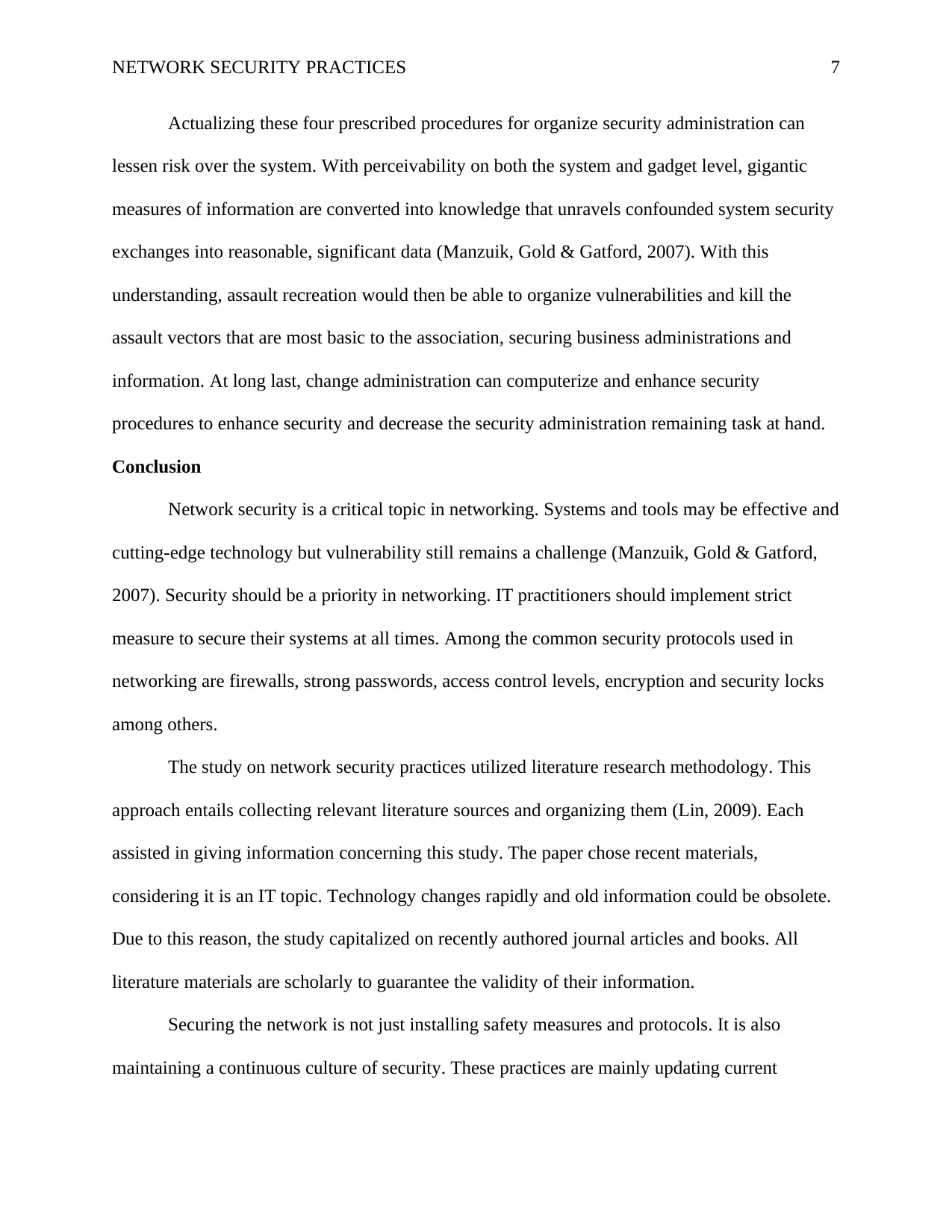
NETWORK SECURITY PRACTICES
Actualizing these four prescribed procedures for organize security administration can
lessen risk over the system. With perceivability on both the system and gadget level, gigantic
measures of information are converted into knowledge that unravels confounded system security
exchanges into reasonable, significant data (Manzuik, Gold & Gatford, 2007). With this
understanding, assault recreation would then be able to organize vulnerabilities and kill the
assault vectors that are most basic to the association, securing business administrations and
information. At long last, change administration can computerize and enhance security
procedures to enhance security and decrease the security administration remaining task at hand.
Conclusion
Network security is a critical topic in networking. Systems and tools may be effective and
cutting-edge technology but vulnerability still remains a challenge (Manzuik, Gold & Gatford,
2007). Security should be a priority in networking. IT practitioners should implement strict
measure to secure their systems at all times. Among the common security protocols used in
networking are firewalls, strong passwords, access control levels, encryption and security locks
among others.
The study on network security practices utilized literature research methodology. This
approach entails collecting relevant literature sources and organizing them (Lin, 2009). Each
assisted in giving information concerning this study. The paper chose recent materials,
considering it is an IT topic. Technology changes rapidly and old information could be obsolete.
Due to this reason, the study capitalized on recently authored journal articles and books. All
literature materials are scholarly to guarantee the validity of their information.
Securing the network is not just installing safety measures and protocols. It is also
maintaining a continuous culture of security. These practices are mainly updating current
7
Actualizing these four prescribed procedures for organize security administration can
lessen risk over the system. With perceivability on both the system and gadget level, gigantic
measures of information are converted into knowledge that unravels confounded system security
exchanges into reasonable, significant data (Manzuik, Gold & Gatford, 2007). With this
understanding, assault recreation would then be able to organize vulnerabilities and kill the
assault vectors that are most basic to the association, securing business administrations and
information. At long last, change administration can computerize and enhance security
procedures to enhance security and decrease the security administration remaining task at hand.
Conclusion
Network security is a critical topic in networking. Systems and tools may be effective and
cutting-edge technology but vulnerability still remains a challenge (Manzuik, Gold & Gatford,
2007). Security should be a priority in networking. IT practitioners should implement strict
measure to secure their systems at all times. Among the common security protocols used in
networking are firewalls, strong passwords, access control levels, encryption and security locks
among others.
The study on network security practices utilized literature research methodology. This
approach entails collecting relevant literature sources and organizing them (Lin, 2009). Each
assisted in giving information concerning this study. The paper chose recent materials,
considering it is an IT topic. Technology changes rapidly and old information could be obsolete.
Due to this reason, the study capitalized on recently authored journal articles and books. All
literature materials are scholarly to guarantee the validity of their information.
Securing the network is not just installing safety measures and protocols. It is also
maintaining a continuous culture of security. These practices are mainly updating current
7
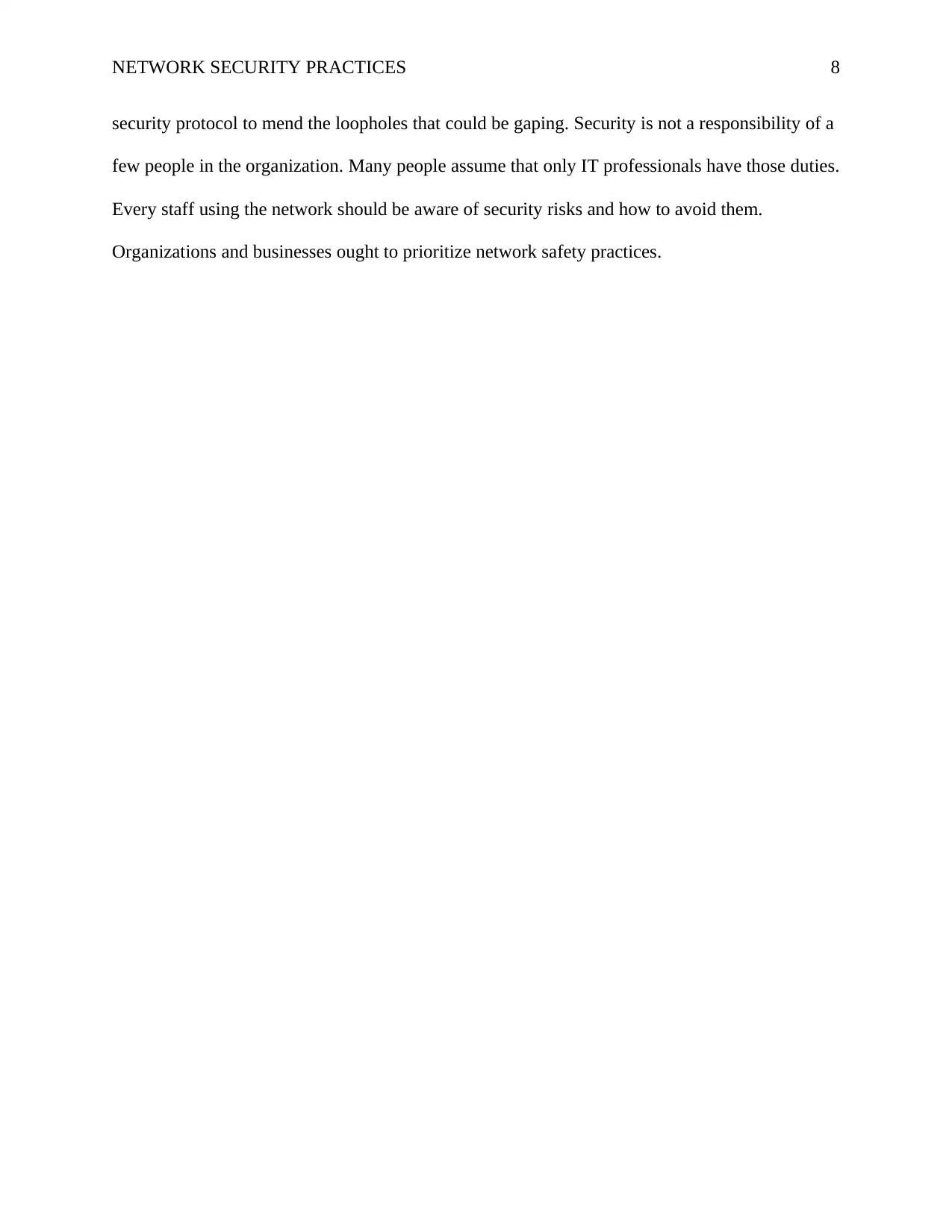
NETWORK SECURITY PRACTICES
security protocol to mend the loopholes that could be gaping. Security is not a responsibility of a
few people in the organization. Many people assume that only IT professionals have those duties.
Every staff using the network should be aware of security risks and how to avoid them.
Organizations and businesses ought to prioritize network safety practices.
8
security protocol to mend the loopholes that could be gaping. Security is not a responsibility of a
few people in the organization. Many people assume that only IT professionals have those duties.
Every staff using the network should be aware of security risks and how to avoid them.
Organizations and businesses ought to prioritize network safety practices.
8
⊘ This is a preview!⊘
Do you want full access?
Subscribe today to unlock all pages.

Trusted by 1+ million students worldwide
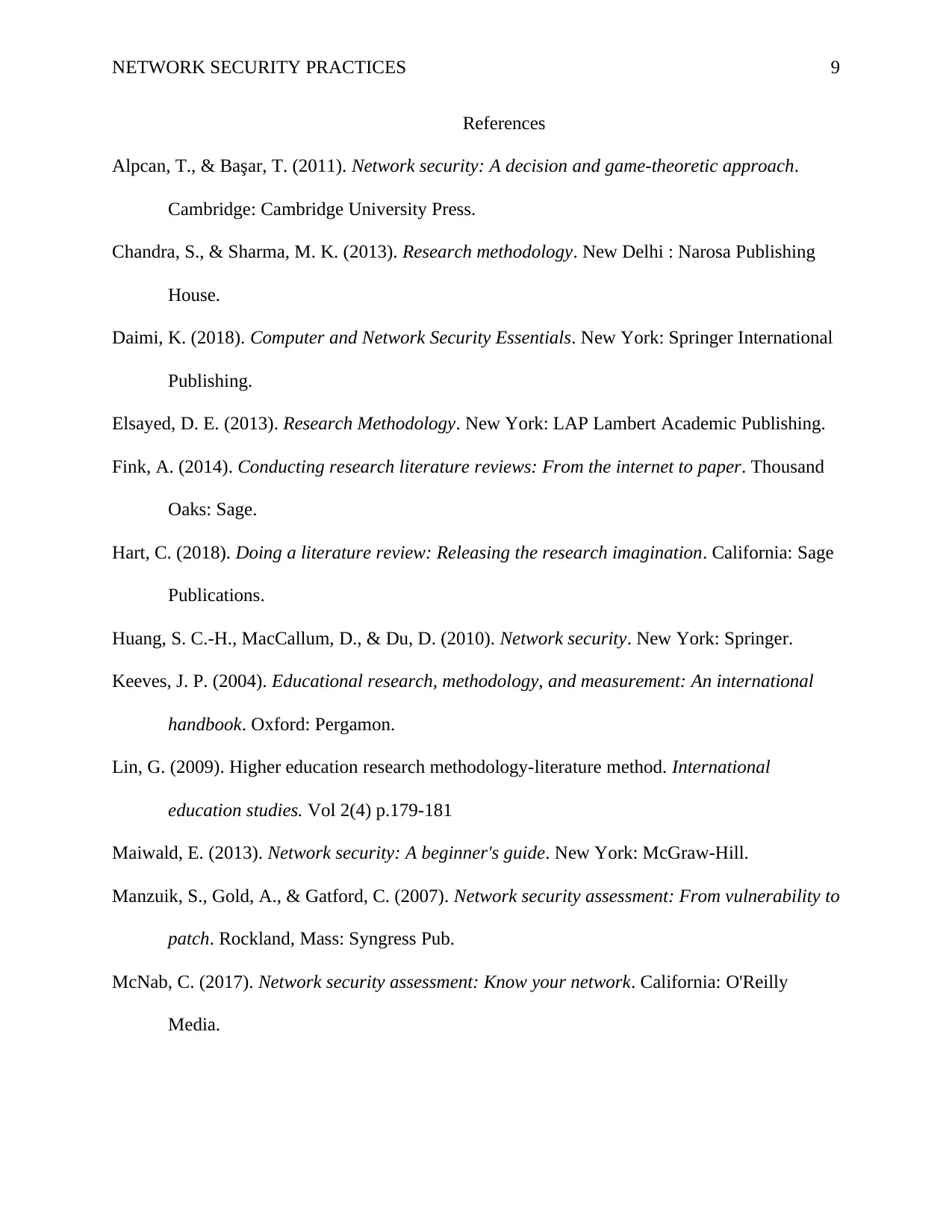
NETWORK SECURITY PRACTICES
References
Alpcan, T., & Başar, T. (2011). Network security: A decision and game-theoretic approach.
Cambridge: Cambridge University Press.
Chandra, S., & Sharma, M. K. (2013). Research methodology. New Delhi : Narosa Publishing
House.
Daimi, K. (2018). Computer and Network Security Essentials. New York: Springer International
Publishing.
Elsayed, D. E. (2013). Research Methodology. New York: LAP Lambert Academic Publishing.
Fink, A. (2014). Conducting research literature reviews: From the internet to paper. Thousand
Oaks: Sage.
Hart, C. (2018). Doing a literature review: Releasing the research imagination. California: Sage
Publications.
Huang, S. C.-H., MacCallum, D., & Du, D. (2010). Network security. New York: Springer.
Keeves, J. P. (2004). Educational research, methodology, and measurement: An international
handbook. Oxford: Pergamon.
Lin, G. (2009). Higher education research methodology-literature method. International
education studies. Vol 2(4) p.179-181
Maiwald, E. (2013). Network security: A beginner's guide. New York: McGraw-Hill.
Manzuik, S., Gold, A., & Gatford, C. (2007). Network security assessment: From vulnerability to
patch. Rockland, Mass: Syngress Pub.
McNab, C. (2017). Network security assessment: Know your network. California: O'Reilly
Media.
9
References
Alpcan, T., & Başar, T. (2011). Network security: A decision and game-theoretic approach.
Cambridge: Cambridge University Press.
Chandra, S., & Sharma, M. K. (2013). Research methodology. New Delhi : Narosa Publishing
House.
Daimi, K. (2018). Computer and Network Security Essentials. New York: Springer International
Publishing.
Elsayed, D. E. (2013). Research Methodology. New York: LAP Lambert Academic Publishing.
Fink, A. (2014). Conducting research literature reviews: From the internet to paper. Thousand
Oaks: Sage.
Hart, C. (2018). Doing a literature review: Releasing the research imagination. California: Sage
Publications.
Huang, S. C.-H., MacCallum, D., & Du, D. (2010). Network security. New York: Springer.
Keeves, J. P. (2004). Educational research, methodology, and measurement: An international
handbook. Oxford: Pergamon.
Lin, G. (2009). Higher education research methodology-literature method. International
education studies. Vol 2(4) p.179-181
Maiwald, E. (2013). Network security: A beginner's guide. New York: McGraw-Hill.
Manzuik, S., Gold, A., & Gatford, C. (2007). Network security assessment: From vulnerability to
patch. Rockland, Mass: Syngress Pub.
McNab, C. (2017). Network security assessment: Know your network. California: O'Reilly
Media.
9
Paraphrase This Document
Need a fresh take? Get an instant paraphrase of this document with our AI Paraphraser
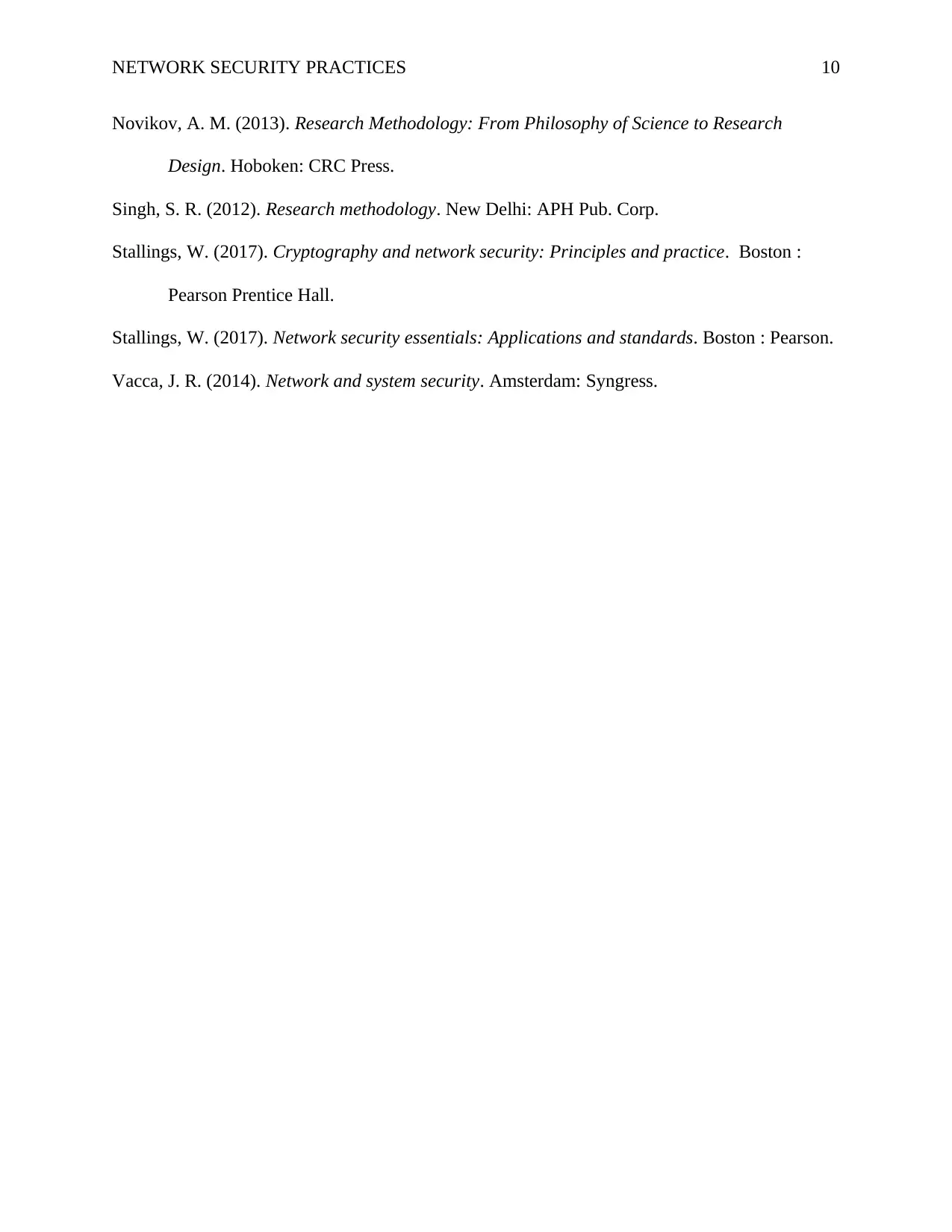
NETWORK SECURITY PRACTICES
Novikov, A. M. (2013). Research Methodology: From Philosophy of Science to Research
Design. Hoboken: CRC Press.
Singh, S. R. (2012). Research methodology. New Delhi: APH Pub. Corp.
Stallings, W. (2017). Cryptography and network security: Principles and practice. Boston :
Pearson Prentice Hall.
Stallings, W. (2017). Network security essentials: Applications and standards. Boston : Pearson.
Vacca, J. R. (2014). Network and system security. Amsterdam: Syngress.
10
Novikov, A. M. (2013). Research Methodology: From Philosophy of Science to Research
Design. Hoboken: CRC Press.
Singh, S. R. (2012). Research methodology. New Delhi: APH Pub. Corp.
Stallings, W. (2017). Cryptography and network security: Principles and practice. Boston :
Pearson Prentice Hall.
Stallings, W. (2017). Network security essentials: Applications and standards. Boston : Pearson.
Vacca, J. R. (2014). Network and system security. Amsterdam: Syngress.
10
1 out of 11
Related Documents
Your All-in-One AI-Powered Toolkit for Academic Success.
+13062052269
info@desklib.com
Available 24*7 on WhatsApp / Email
![[object Object]](/_next/static/media/star-bottom.7253800d.svg)
Unlock your academic potential
Copyright © 2020–2025 A2Z Services. All Rights Reserved. Developed and managed by ZUCOL.





